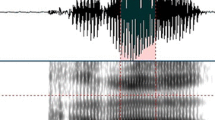Abstract
Automatic speech recognition is a technology that allows a computer to transcribe in real time spoken words into readable text. In this work an HMM automatic speech recognition system was created to detect smoker speaker. This research project is carried out using Amazigh language for comparison of the voice of normal persons to smokers one. To achieve this goal, two experiments were performed, the first one to test the performance of the system for non-smokers for different parameters. The second experiment concern smokers speakers. The corpus used in this system is collected from two groups of speaker, non-smokers and smokers native Morocan tarifit speakers aged between 25 and 55 years. Our experimental results show that we can use our system to make diagnostic for smoking people and confirm that a speaker is smoker when the observed recognition rate is below 50%.






Similar content being viewed by others
References
Carnegie Mellon University. Sphinx-4. Available http://cmusphinx.sourceforge.net.
Chaker, S. (1984). Textes en linguistique berbère: introduction au domaine berbère. Paris: Ed. du C.N.R.S.
Fadoua, A. A., & Siham, B. (2012). Natural language processing for Amazigh language: Challenges and future directions. Language Technology for Normalisation of Less-Resourced Languages, 19.
Gonzalez, J., & Capri, A. (2014). Early effects of smoking on the voice: A multidimensional study. Medical Science Monitor, 10(no 12), CR649–CR 656.
Huang, X., Acero, A., & Hon, H. -W. (2001). Spoken language processing: A guide to theory, algorithm, and system development. Upper Saddle River: Prentice Hall PTR. (Foreword By: R. Reddy).
Kimutai, S. K., Milgo, E., and Gichoya, D. (2013). Isolated Swahili Words Recognition using Sphinx4. International Journal of Emerging Science and Engineering. 2(2), 2319–6378.
Mckeating, K., Bali, I. M., & Dundee, J. W. (1988). The effects of thiopentone and propofol on upper airway integrity. Anaesthesia, 43(8), 638–640.
Muhammad, G., Mesallam, T. A., Malki, K. H., Farahat, M., Alsulaiman, M., & Bukhari, M. (2011). Formant analysis in dysphonic patients and automatic Arabic digit speech recognition. Biomedical Engineering Online, 10(41), 1–12.
Ouakrim, O. (1995). Fonética y fonología del Bereber. Survey: University of Autònoma de Barcelona.
Rabiner, L. R. (1989). A tutorial on hidden Markov models and selected applications in speech recognition. Proceedings of the IEEE 77(no. 2), 257–286.
Ridouane, R. (2003). Suites de consonnes en berbère: phonétique et phonologie. PhD diss. Université de la Sorbonne nouvelle-Paris III.
Satori, H., & Elhaoussi, F. (2014). Investigation Amazigh speech recognition using CMU tools. International Journal of Speech Technology, 17(3), 235–243.
Satori, H., Harti, M., & Chenfour, N. (2007). Arabic speech recognition system based on CMUSphinx. Computational Intelligence and Intelligent Informatics, 2007. ISCIII’07. International Symposium on. IEEE.
Shaukat, A., Hazrat, A., & Usman, A. (2016). Automatic Urdu Speech Recognition using Hidden Markov Model. International Conference on Image, Vision and Computing (ICIVC), IEEE, Portsmouth, UK.
Varela, A., Cuayáhuitl, H., & Nolazco-Flores, J. A. (2003). Creating a Mexican Spanish version of the CMU Sphinx-III speech recognition system. In Iberoamerican Congress on Pattern Recognition (pp. 251–158). Berlin: Springer.
Verdonck-de Leeuw, I. M., & Mahieu, H. F. (2004). Vocal aging and the impact on daily life: A longitudinal study. Journal of Voice, 18(2), 193–202.
“Wavesurfer”, Version1.8.8p4. Retrieved January 2016, from http://sourceforge.net/projects/wavesurfer.
Funding
Funding was provided by Sidi Mohemed ben abdellah University (Grant No. ID0EMQAE137).
Author information
Authors and Affiliations
Corresponding author
Rights and permissions
About this article
Cite this article
Satori, H., Zealouk, O., Satori, K. et al. Voice comparison between smokers and non-smokers using HMM speech recognition system. Int J Speech Technol 20, 771–777 (2017). https://doi.org/10.1007/s10772-017-9442-0
Received:
Accepted:
Published:
Issue Date:
DOI: https://doi.org/10.1007/s10772-017-9442-0




